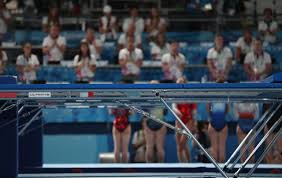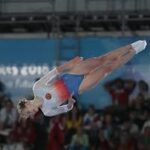Trampolining originated as a training tool and circus novelty act. But starting in the 1940s, it rapidly evolved into a formal competitive sport requiring tremendous athleticism, precision, and grace. Dedicated athletes and organizations pushed for trampolining to be recognized as an athletic endeavor in its own right, distinct from the circus traditions.
Fast forward to the present day and Trampolining has risen to become one of the most-watched Olympic sports globally.

Table of Contents
- Early Trampoline Competitions
- Developing Rules and Judging
- Notable Pioneers and Champions
- Trampoline Technique Innovations
- National Trampoline Organizations
- International Competitions: 1950s-1960s
- Trampolining’s Split From Gymnastics
- Trampolining Comes of Age
Early Trampoline Competitions
The first trampoline competitions were humble affairs, but they marked the beginnings of a shift in perception. Small local trampoline events were held in the U.S. Midwest in the 1940s, attracting young gymnasts intrigued by the new apparatus (1).
In 1947, the first National Trampoline Competition was held at the University of Iowa, organized by trampoline inventor George Nissen. Early stars like Hall of Famer Woody Goss demonstrated a series of twists and somersaults that laid the foundations for competitive form (2).
Just two years later, trampolining took its biggest early leap when London hosted the first World Trampoline Championships in 1949. Top athletes from Europe and the U.S. vied for the first international trampoline titles, cementing it as a global competitive sport.

Developing Rules and Judging
Early trampoline competitions were mostly exhibitions judged by creativity and showmanship. But as events formalized in the 1950s, more objective scoring systems evolved (3).
The Universal Trampoline Society published recommendations for judging and best practices for routine construction. Difficulty scores rewarded more complex skills like triple somersaults. Execution scores assessed factors like body form, control, height and precision. Trampoline competitions started adhering to higher standards befitting an elite sport.
Notable Pioneers and Champions
Certain athletes were instrumental in developing competitive trampoline techniques and legitimacy:
- Dan Millman – Regarded as the “father of modern trampolining,” Millman won two national titles in the 1960s and performed pioneering triples and quadruple somersaults (4).
- Larry Griswold – A legendary coach who trained top talents starting in the 1940s and co-authored the first USA Trampoline safety handbook in 1960.
- George Nissen – The trampoline inventor remained a huge influence as a coach and leader in trampoline organizations.
- Judy Wills Cline – Won 10 consecutive national titles between 1959 and 1968, still the longest winning streak in USA trampoline history (5).
These individuals established competitive trampolining as requiring immense skill and dedication, worthy of respect as an athletic pursuit.
Trampoline Technique Innovations
New techniques expanded the creative possibilities of trampoline routines:
- Twisting – Athletes mastered multiple front and back twists in combination with somersaults.
- Barani – Front somersault with a half twist popularized by Denis Barani in the 1960s (6).
- Triffis – Back somersault with a half twist first completed in the 1960s.
- Cardiac Flip – Backflip with a full twist ending in prone position rather than feet first.
Such flourishes added complexity, variety and difficulty to routines. Points could be racked up by stringing skills together in novel sequences.
National Trampoline Organizations
Starting in the 1950s, national trampoline organizations formed to develop the sport and hold sanctioned events:
- British Trampoline Federation (1959)
- United States Trampoline Association (1960)
- Canadian Trampoline Union (1965)
- Australasian Trampoline Union (1969)
These governing bodies steadily professionalized trampolining with coach certifications, safety standards, athlete development pathways and formal international competition (7).
International Competitions: 1950s-1960s
International meets accelerated trampoline’s global growth and technical progress:
- At the 1956 World Championships, East Germany emerged as a new force, hinting at Cold War athletic rivalries to come (8).
- The 1964 Olympics in Tokyo hosted trampoline as a demonstration event, raising its international profile.
- American Wyatt Trimpe won 3 straight World Championship titles from 1961-1965 as the US dominated.
- At the 1967 Worlds, the Soviet Union signaled a challenge to US supremacy with its first international trampoline titles.
This competitive leapfrogging between nations demonstrated trampolining’s coming of age as a serious international sport.
Trampolining’s Split From Gymnastics
For many years, trampoline was governed independently from the International Gymnastics Federation (FIG) which oversees most gymnastic disciplines. Trampoline leaders long lobbied for integration into FIG as a key step toward Olympic inclusion. After years of skepticism, trampolining was finally embraced by the FIG in 1999.
In the early days, competitive trampolining was governed by national federations like USA Trampoline and the International Trampoline Federation (FIT). But the FIG, which controlled access to the Olympics, resisted accepting trampoline as a “real” gymnastic sport. They saw it as less disciplined and more for entertainment than their traditional gymnastics events.
But trampoline continued to grow in popularity and athleticism. FIT persistently made the case that trampoline deserved FIG sanctioning and a potential Olympic future. Finally, in 1998, the FIG established a Trampoline Technical Committee to formally oversee international trampoline competitions. This milestone showed that trampolining was starting to gain legitimacy in the eyes of the FIG.
The next year, FIT dissolved and merged into the FIG, bringing trampolining under direct FIG governance. This unity helped demonstrate trampolining was mature enough for the Olympics. The FIG Trampoline Technical Committee provided the needed oversight and standards.
After decades of lobbying and proving itself, trampoline finally achieved FIG acceptance. This pivotal milestone removed a huge roadblock and set trampolining on a path to its ultimate Olympic debut in 2000. Earning FIG sanctioning was a major achievement in establishing trampolining as an equal amongst gymnastics sports.
Trampolining Comes of Age
In just a few decades, trampolining rapidly transformed from a training tool and circus act to a demanding athletic pursuit of its own. Through formalization and constant innovation, trampoline pioneers proved bouncing could be taken as seriously as the most elite sports. Their efforts earned trampolining recognition alongside artistic and rhythmic gymnastics, culminating in its rightful Olympic spotlight.
References:
- https://usagym.org/pages/gymnastics101/history/trampolinehist.pdf
- http://www.usghof.com/woody-goss.html
- https://journals.uair.arizona.edu/index.php/azine/article/download/18267/18067/
- https://www.millman.com/about-dan-millman/
- https://usagym.org/pages/gymnastics101/history/legends.html?prog=w
- http://www.fig-gymnastics.com/site/about/disciplines/tra
- https://usagym.org/PDFs/Pressbox/History/trampolinehist.pdf
- http://x157.de/EM_WM/EM_Trampolin_Historie_eng.pdf
- https://www.british-gymnastics.org/technical-information/disciplines/trampoline/history
- The 12 Types of Trampoline (explained)
 Trampolines, a staple of joy and fitness, cater to all ages, inspiring kids and adults alike to leap out of their indoor routines into a… Read more: The 12 Types of Trampoline (explained)
Trampolines, a staple of joy and fitness, cater to all ages, inspiring kids and adults alike to leap out of their indoor routines into a… Read more: The 12 Types of Trampoline (explained) - Trampoline In The Olympics (History)
 Trampolining has followed a bumpy road on its quest for inclusion in the Olympic Games. From skepticism and roadblocks to breakthrough performances, trampoline athletes have… Read more: Trampoline In The Olympics (History)
Trampolining has followed a bumpy road on its quest for inclusion in the Olympic Games. From skepticism and roadblocks to breakthrough performances, trampoline athletes have… Read more: Trampoline In The Olympics (History) - The Top 9 Trampoline Health Benefits
 Trampolining, once just a popular backyard activity, is now a serious fitness trend. It’s a fun way to get your body moving, burn calories, and… Read more: The Top 9 Trampoline Health Benefits
Trampolining, once just a popular backyard activity, is now a serious fitness trend. It’s a fun way to get your body moving, burn calories, and… Read more: The Top 9 Trampoline Health Benefits - Are In Ground Trampolines Safer?
 Backyard trampolines are a fantastic way to keep children of all ages happy, healthy and busy. Choosing the safest type of trampoline for your family… Read more: Are In Ground Trampolines Safer?
Backyard trampolines are a fantastic way to keep children of all ages happy, healthy and busy. Choosing the safest type of trampoline for your family… Read more: Are In Ground Trampolines Safer? - How to Winterize A Trampoline (guide)
 Winter is not just a season of snow and cozy firesides; it’s also a time when our beloved outdoor equipment needs extra care to survive… Read more: How to Winterize A Trampoline (guide)
Winter is not just a season of snow and cozy firesides; it’s also a time when our beloved outdoor equipment needs extra care to survive… Read more: How to Winterize A Trampoline (guide) - How to Choose a Trampoline (guide)
 In this guide, we’ll bounce through the essentials of how to choose a trampoline, from size and shape to durability and bounce quality, ensuring you… Read more: How to Choose a Trampoline (guide)
In this guide, we’ll bounce through the essentials of how to choose a trampoline, from size and shape to durability and bounce quality, ensuring you… Read more: How to Choose a Trampoline (guide)
